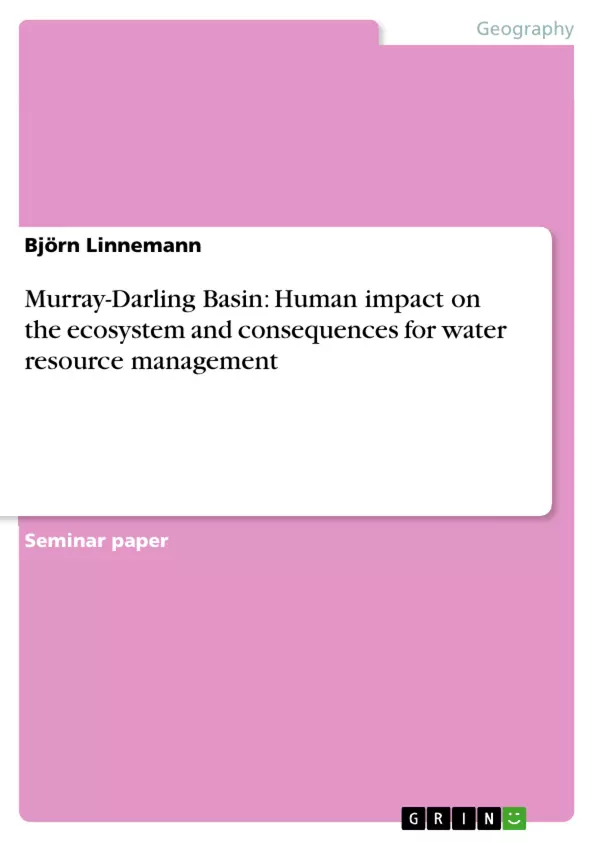The Murray Darling Basin is the one of the most important water resources for mainland Australia. Climate and consumption patterns threaten the availability of water. An analysis of current water resource management and its challenges.
Inhaltsverzeichnis (Table of Contents)
- Scope and aim of the paper
- Australia’s climate situation
- Trend in mean annual rainfall
- The Murry Darling Basin
- Location of the Murray Darling Basin
- Map of land use across Australia and major agricultural zones
- Measures taken for mitigation of water shortage
- The Murray Darling Basin from an integrated perspective
- Weaknesses of current water management
Zielsetzung und Themenschwerpunkte (Objectives and Key Themes)
This paper examines the intricate relationship between human activities and the Murray Darling Basin ecosystem, specifically focusing on the escalating water shortage and the effectiveness of current management strategies. The paper aims to provide a comprehensive understanding of this issue by incorporating a holistic perspective that considers human ecology and environmental justice. Key themes explored include:- The impact of human activities on the Murray Darling Basin ecosystem
- The role of climate change and its impact on water scarcity
- The effectiveness of current water management strategies in addressing water shortage
- The importance of an integrated approach that considers human ecology and environmental justice
- The need for greater public participation and stakeholder engagement in water management decisions
Zusammenfassung der Kapitel (Chapter Summaries)
- Scope and aim of the paper: This chapter introduces the focus of the paper, which is to analyze the water shortage situation in the Murray Darling Basin and its underlying causes. It outlines the utilization of human ecology and environmental justice concepts to better understand the complexities of the issue.
- Australia’s climate situation: This chapter provides an overview of Australia’s climate and its impact on water resources. It highlights the trends in rainfall patterns, particularly the drying trend in the south-east, and the impact of climate change on water availability.
- The Murry Darling Basin: This chapter delves into the specific characteristics of the Murray Darling Basin, including its significance as Australia's largest catchment area and main water source for major cities and agriculture. It discusses the impact of overexploitation, drought, and climate change on water levels in the basin.
- Measures taken for mitigation of water shortage: This chapter examines the various measures implemented by Australian authorities to manage water shortage, including water allocation agreements, restrictions, water trading, and initiatives like the National Water Initiative. It focuses on the evolution of these measures over time and their effectiveness in addressing the issue.
- The Murray Darling Basin from an integrated perspective: This chapter explores the interplay between human actions and the Murray Darling Basin ecosystem. It analyzes the concept of human ecology, highlighting the interconnectedness between society, nature, and human actions. The chapter emphasizes the complexities of identifying human impact on the ecosystem in the context of natural variations and climate change.
Schlüsselwörter (Keywords)
The primary focus of the text is on the Murray Darling Basin ecosystem, its water resource management, and the interplay of human activities with natural processes. Key themes include human ecology, environmental justice, climate change, water shortage, water allocation, water trading, and stakeholder participation. The text analyzes the effectiveness of current management strategies and argues for a more integrated approach that recognizes the interconnectedness of social, economic, and ecological factors.
Ende der Leseprobe aus 22 Seiten
- nach oben
- Arbeit zitieren
- Björn Linnemann (Autor:in), 2010, Murray-Darling Basin: Human impact on the ecosystem and consequences for water resource management, München, GRIN Verlag, https://www.grin.com/document/198580
Blick ins Buch



